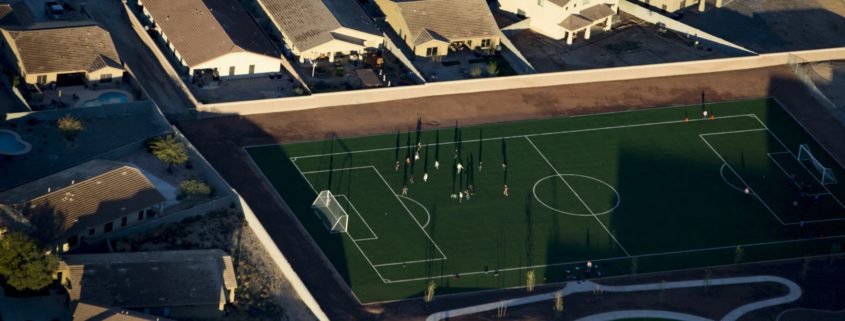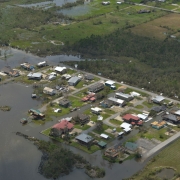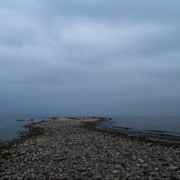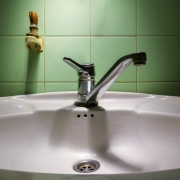Saving Water Lowered Rates in Two Arizona Cities
Breakthrough research makes financial case for municipal water conservation.
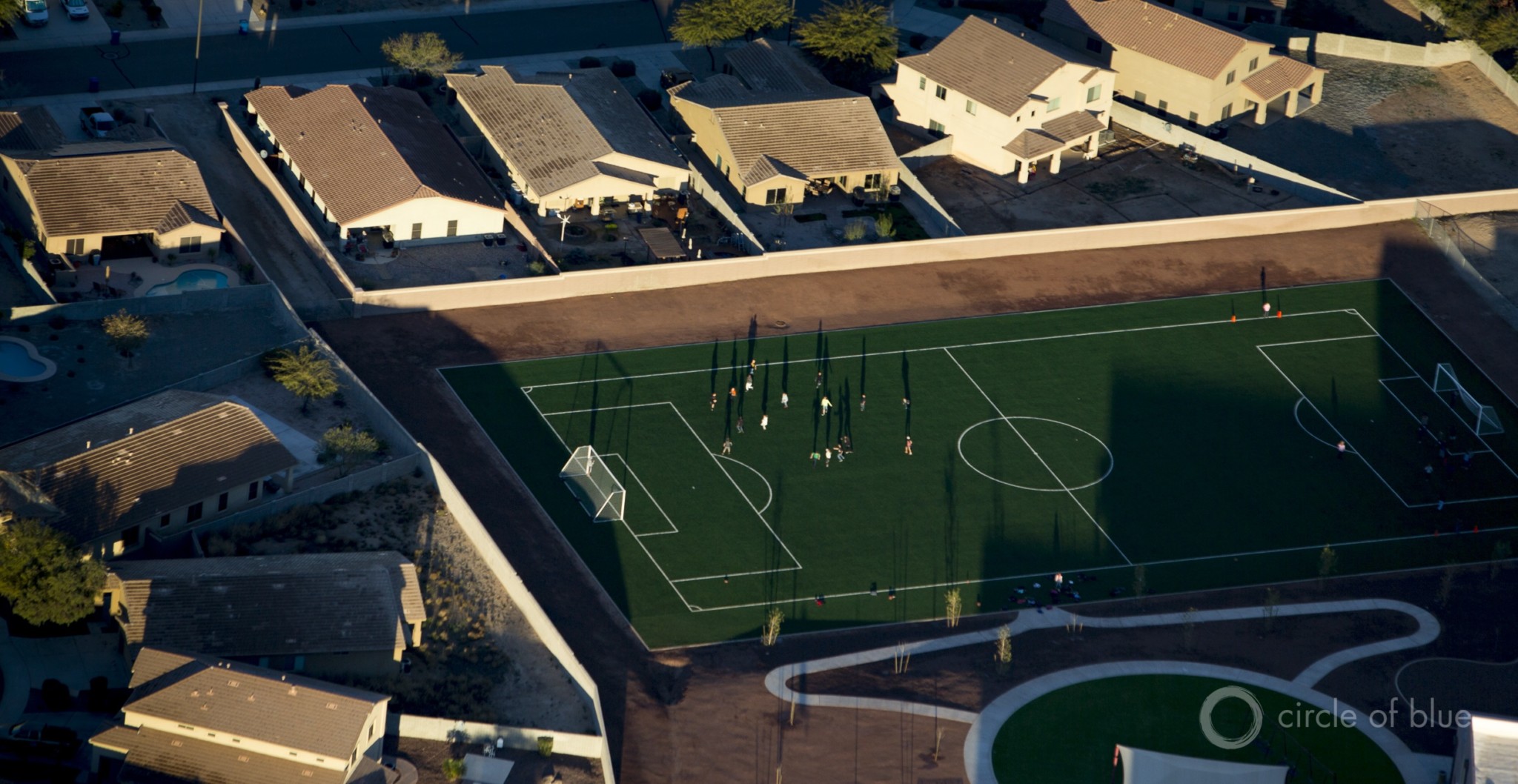
Morning sun lights up homes in central Arizona. Photo © J. Carl Ganter / Circle of Blue
By Brett Walton, Circle of Blue
“Why conserve if our rates are going to go up?”
It’s a question that Candice Rupprecht, water conservation manager for the city of Tucson, Arizona, hears frequently at community meetings. Residents are frustrated by what they see as an unjust reward for watering the lawn two times a week instead of four.
It’s a question that she answered, but not with any real precision. Until now.
A research project conducted in Tucson and Gilbert, a boom town in central Arizona, sought to measure the effect on current water prices if both cities had not embraced conservation measures years earlier.
Water supply, transport, and treatment infrastructure is expensive. Conserving water saves money because it avoids the need to build pipelines and reservoirs, expand treatment plants, and pump and treat extra water. Those measures, in turn, mean not having to pay interest on construction loans, and not having to acquire new water supplies. Rates in many cases do not need to rise to pay for repairs and maintenance. In the long run, according to the research by the Alliance for Water Efficiency, a Chicago-based nonprofit, conservation is a winning financial strategy.
The study, published in early July, found that Tucson’s rates for water and sewer service are at least 11.7 percent lower now than if residents had not sharply cut their water use starting in the mid-1980s. The lower rates reflect the remarkable fact that Tucson’s total water use in 2015 was roughly the same as three decades ago, when the water department served 240,000 fewer customers. That finding gives managers like Rupprecht ammunition for the value of conserving water.
In Gilbert, the study determined that water and sewer rates are 5.8 percent lower than they would have been without conservation measures. A big area of savings, according to the analysis, is in connection charges for new customers who hook into the system. The cost of connecting to Gilbert’s water system is 45 percent lower today than it would have been had Gilbert not taken measures to conserve water.
“It’s an important story to convey to decision makers, who have the difficult job of justifying rate increases,” Peter Mayer, technical adviser for the Alliance for Water Efficiency and primary report author, told Circle of Blue. Utility customers, he noted, sometimes complain when they see rates and water consumption going in opposite directions. “It’s a fair question that deserves a fair answer. That’s what we’re trying to do with this analysis.”
The studies add to an intensifying local and national debate about the cost of modernizing water infrastructure and securing adequate water supplies, according to Janice Beecher, director of Michigan State University’s Institute of Public Utilities.
Dallas, Denver, Las Vegas, San Antonio, and numerous smaller Sun Belt and western cities in the United States are planning to expand existing facilities or construct big pipelines to tap new water sources. At the same time, there is a chorus, rising in volume, that the country needs to reinvest in dilapidated water systems. The Tucson and Gilbert studies, Beecher argues, should give decision makers pause about what sorts of projects to pursue.
“We hear a lot about the massive need for infrastructure investment,” Beecher wrote in an email to Circle of Blue. “While I don’t dispute that there is need, I question whether we are running the risk of simply replacing in-kind, and missing the chance to capture the benefits of efficiency and to re-optimize our systems in terms of both capital investment and operations. It would be a societal shame to miss this opportunity.”
A Common Story with Different Details
Gilbert and Tucson are the second and third cities for which Mayer has run the conservation analysis. The first was Westminster, a suburb of Denver. Westminster’s conservation cost savings, estimated in a study published in 2013, were eye-popping: water and sewer connection fees would have been 80 percent higher if water demand had continued at the level it was in 1980. Water and sewer rates would have been 91 percent higher. Westminster’s savings were so large because acquiring new water supplies in Colorado’s high-growth Front Range would have been costly.
Mayer, a nationally respected water analyst who testified last fall in a U.S. Supreme Court case involving a river basin shared by Georgia and Florida, says he has learned that though there is a common narrative in these analyses — that conservation often leads to long-term cost savings — the details are particular to each case. “There’s a different story for each city,” he said.
The Gilbert and Tucson studies were sponsored by the Alliance for Water Efficiency, a nonprofit that supports water conservation efforts in North America. Funding came from the Walton Family Foundation, which stipulated that cities in the Colorado River Basin, a region of interest, be selected.
The analysis begins by choosing a baseline year, usually a point at which water use or population began to change significantly. For Gilbert, Mayer chose 1997, a year preceding a growth spurt, and for Tucson, 1989, the year that average residential water use peaked.
The next step is to project current water demands and wastewater flows based on the upward trends that were in place in the baseline year. With that information, Mayer calculated the additional infrastructure needed for treatment and delivery, any additional water supplies that would need to be acquired, and the cost of bringing that water to the city. Financial data, developed in conjunction with city water officials, was tailored to each city using real-world figures for operations, maintenance, construction cost, and debt payments.
Conservation Now and into the Future
The two cities used a mix of strategies to bring down water consumption. For both, single-family homes comprise roughly 70 percent of total water use. Tucson requires commercial properties to install native desert landscaping. The water department also provides rebates for water-efficient devices and has a rate structure in which the price increases steeply as water use rises. Single-family homes in Tucson have cut water use by 42 percent since 1989.
Gilbert does not offer rebates, but homeowners can request a water “checkup” that identifies ways to decrease outdoor watering, often the largest opportunity for savings. Haley Paul, the city’s conservation specialist, told Circle of Blue that the average household that completes a checkup reduces water use by 50,000 gallons the following year. Water use per person has been cut in half since 1978.
Paul welcomed the study and said that Gilbert officials would point to the results the next time the city has to raise rates, which it has not done since 2009.
“It helps us in messaging, first of all,” she said. “And it’s another reason for people to conserve.”
But for how long can residents keep up the conservation pace? Going from 200 gallons per person to 100 gallons per person is much easier than getting to 50 gallons. But based on data from the most water-conscious Australian and Californian cities, it can be done. Still, utility representatives from some growing cities in the American West argue that conserve will only go so far and that they will eventually need new supplies.
Tucson is not yet at that point, according to Rupprecht. Most people have converted their landscaping to native desert plants, but for indoor use “there is still room to go,” she said. Older houses may not have switched to efficient appliances and new technology to improve household fixtures is always being developed. “Our job is to figure out where the opportunities are,” she explained.
Brett writes about agriculture, energy, infrastructure, and the politics and economics of water in the United States. He also writes the Federal Water Tap, Circle of Blue’s weekly digest of U.S. government water news. He is the winner of two Society of Environmental Journalists reporting awards, one of the top honors in American environmental journalism: first place for explanatory reporting for a series on septic system pollution in the United States(2016) and third place for beat reporting in a small market (2014). He received the Sierra Club’s Distinguished Service Award in 2018. Brett lives in Seattle, where he hikes the mountains and bakes pies. Contact Brett Walton

